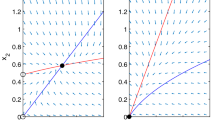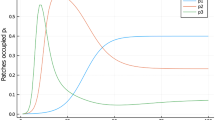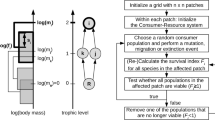Abstract
A central question of ecology is what determines the presence and abundance of species at different locations. In cases of ecological pattern formation, population sizes are largely determined by spatially distributed interactions and may have very little to do with the habitat template. We find pattern formation in a single-species metapopulation model with quasi-local competition, but only if the populations have (at least) two age or stage classes. Quasi-local competition is modeled using an explicit resource competition model with fast resource dynamics, and assuming that adults, but not juveniles, spend a fraction of their foraging time in habitat patches adjacent to their home patch. Pattern formation occurs if one stage class depletes the common resource but the shortage of resource affects mostly the other stage. When the two stages are spatially separated due to quasi-local competition, this results in competitive exclusion between the populations. We find deep similarity between spatial pattern formation and population cycles due to competitive exclusion between cohorts of biennial species, and discuss the differences between the present mechanism and established ways of pattern formation such as diffusive instability and distributed competition with local Allee-effects.
Similar content being viewed by others
References
Amarasekare, P., 1998. Interactions between local dynamics and dispersal: Insights from single-species models. Theor. Popul. Biol. 53, 44–59.
Beverton, R.J.H., Holt, S.J., 1957. On the Dynamics of Exploited Fish Populations [Fish. Invest., vol. 19, ser. 2]. Her Majesty's Stationery Office, London.
Britton, N.F., 1989. Aggregation and the competitive exclusion principle. J. Theor. Biol. 136, 57–66.
Bulmer, M.G., 1977. Periodical insects. Am. Nat. 111, 1099–1117.
Charlesworth, B., 1980. Evolution in Age-Structured Populations. Cambridge University Press, Cambridge, UK.
Davydova, N.V., Diekmann, O., van Gils, S.A., 2003. Year class coexistence or competitive exclusion for strict biennials? J. Math. Biol. 46, 95–131.
De Roos, A.M., McCauley, E., Wilson, W.G., 1998. Pattern formation and the scale of interaction between predators and their prey. Theor. Popul. Biol. 53, 108–130.
Doebeli, M., 1995. Dispersal and dynamics. Theor. Popul. Biol. 47, 82–106.
Doebeli, M., Killingback, T., 2003. Metapopulation dynamics with quasi-local competition. Theor. Popul. Biol. 64, 397–416.
Doebeli, M., Ruxton, G., 1998. Stabilization through spatial pattern formation in metapopulations with long-range dispersal. Proc. R. Soc. Lond. B 265, 1325–1332.
Edelstein-Keshet, L., 1988. Mathematical Models in Biology. Birkhäuser Mathematics Series. McGraw-Hill, Boston, MA.
Furter, J., Grinfeld, M., 1989. Local vs. non-local interactions in population dynamics. J. Math. Biol. 27, 65–80.
Geritz, S.A.H., Kisdi, E., 2004. On the mechanistic underpinning of discrete-time population models with complex dynamics. J. Theor. Biol. 228, 261–269.
Gruntfest, Y., Arditi, R., Dombrovsky, Y., 1997. A fragmented population in a varying environment. J. Theor. Biol. 185, 539–547.
Gurney, W.S.C., Nisbet, R.M., 1976. Spatial pattern and the mechanism of population regulation. J. Theor. Biol. 59, 361–370.
Gyllenberg, M., Hemminki, J., Tammaru, T., 1999. Allee effects can both conserve and create spatial heterogeneity in population densities. Theor. Popul. Biol. 56, 231–242.
Gyllenberg, M., Söderbacka, G., Ericsson, S., 1993. Does migration stabilize local population dynamics? Analysis of a discrete metapopulation model. Math. Biosci. 118, 25–49.
Hassell, M.P., Comins, H.N., May, R.M., 1991. Spatial structure and chaos in insect population dynamics. Nature 353, 255–258.
Hastings, A., 1992. Age dependent dispersal is not a simple process: Density dependence, stability and chaos. Theor. Popul. Biol. 41, 388–400.
Hastings, A., 1993. Complex interactions between dispersal and dynamics: Lessons from the coupled logistic equations. Ecology 74, 1362–1372.
Holmes, E.E., Lewis, M.A., Banks, J.E., Veit, R.R.R., 1994. Partial differential equations in ecology: Spatial interactions and population dynamics. Ecology 75, 17–29.
Kaneko, K., 1998. Diversity, stability and metadynamics: Remarks from coupled map studies. In: Bascompte, J., Solé, R.V. (Eds.), Modeling Spatiotemporal Dynamics in Ecology. Springer Verlag, Berlin, pp. 27–45.
Kisdi, E., Utz, M., 2005. Does quasi-local competition lead to pattern formation in metapopulations? An explicit resource competition model. Theor. Popul. Biol. 68, 133–145.
Klausmeier, C.A., 1999. Regular and irregular patterns in semiarid vegetation. Science 284, 1826–1828.
Leibold, M.A., 1995. The niche concept revisited: Mechanistic models and community context. Ecology 76, 1371–1382.
Levin, S., 1974. Dispersion and population interactions. Am. Nat. 108, 207–228.
Levin, S.A., Segel, L.A., 1985. Pattern generation in space and aspect. SIAM Rev. 27, 45–67.
Lloyd, A.L., 1995. The coupled logistic map: A simple model for the effects of spatial heterogeneity on population dynamics. J. Theor. Biol. 173, 217–230.
Meszéna, G., Gyllenberg, M., Pásztor, L., Metz, J.A.J., 2006. Competitive exclusion and limiting similarity: A unified theory. Theor. Popul. Biol. 69, 68–87.
Murray, J.D., 2003. Mathematical Biology. II. Spatial Models and Biomedical Applications. Springer-Verlag, Berlin.
Rohani, P., May, R.M., Hassell, M.P., 1996. Metapopulations and equilibrium stability: The effects of spatial structure. J. Theor. Biol. 181, 97–109.
Sasaki, A., 1997. Clumped distribution by neighborhood competition. J. Theor. Biol. 186, 415–430.
Segel, L.A., Jackson, J.L., 1972. Dissipative structure: An explanation and an ecological example. J. Theor. Biol. 37, 545–559.
Turing, A.M., 1952. The chemical basis of morphogenesis. Phil. Trans. R. Soc. Lond. B 237, 37–72.
Wikan, A., Mjolhus, E., 1995. Periodicity of 4 in age-structured population models with density dependence. J. Theor. Biol. 173, 109–119.
Author information
Authors and Affiliations
Corresponding author
Rights and permissions
About this article
Cite this article
Utz, M., Kisdi, É. & Doebeli, M. Quasi-Local Competition in Stage-Structured Metapopulations: A New Mechanism of Pattern Formation. Bull. Math. Biol. 69, 1649–1672 (2007). https://doi.org/10.1007/s11538-006-9184-7
Received:
Accepted:
Published:
Issue Date:
DOI: https://doi.org/10.1007/s11538-006-9184-7




